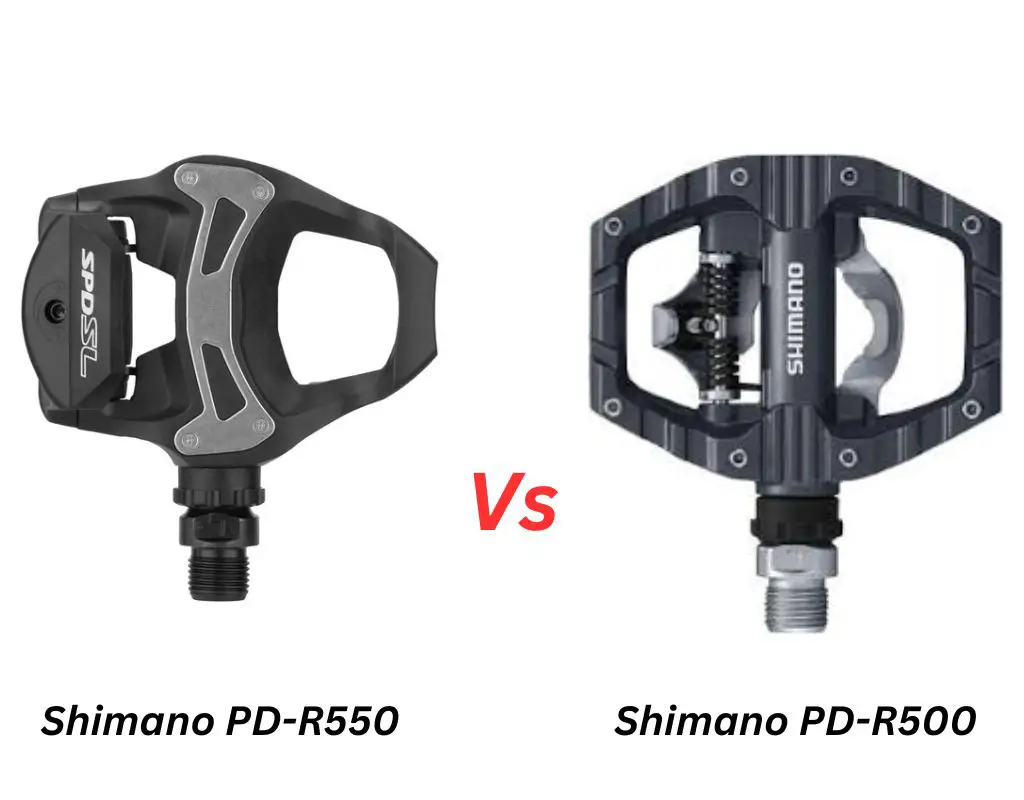
Shimano PD-R550 and the Shimano PD-RS500 are both entry-level SPD-SL pedals that share some features, but also have some differences.
We will compare them based on their specifications, features, pros and cons, and customer feedback.
Specifications
Here is a table that summarizes the main specifications of the two pedals:
| Specification | PD-R550 | PD-RS500 |
| Type | Road | Road |
| Body Material | Composite / Steel | Stainless Steel |
| Pedal Weight | 155 g | 160 g |
| Stack Height | 16.5 mm | 16.8 mm |
| Cleat Type | SPD-SL | SPD-SL |
The Shimano PD-R550 and the Shimano PD-RS500 have similar dimensions and weight, but they differ in their body material and stack height.
The PD-R550 has a composite body with a stainless steel plate, while the PD-RS500 has a stainless steel body. It has a lower stack height of 16.5 mm, compared to 16.8 mm for the PD-RS500.
The PD-R550 has a lower center of gravity and less distance between the pedal and the shoe, which can improve power transfer and stability.
Features
Both pedals have some common features, such as:
- Wide platform for maximum efficient transfer of power
- Sealed mechanism for low maintenance
- Cleat retention adjuster for easy tension adjustment
- Larger entry target for easier engagement
- SPD-SL compatible cleats (SM-SH11) included
However, the PD-R550 has some additional features that make it superior to the PD-RS500, such as:
- Wide bearing placement for stable, uniform load distribution
- Durable composite body that reduces flex and wear
- Lighter spring tension optimized for beginner riders
- Wider spring tension range
Related: Shimano IC1 vs. IC2: Detailed Comparison
Pros and Cons
Based on the specifications and features, here are some pros and cons of each pedal:
Pros: PD-R550
- Lighter and more durable than the PD-RS500
- Lower stack height for better power transfer and stability
- Wider bearing placement for smoother rotation
- Wider spring tension range for more flexibility
- Lighter spring tension for easier clipping in and out
Cons: PD-R550
- More expensive than the PD-RS500
- Composite body may not be as stiff as metal
- Cleats may wear out faster than metal ones
Pros: PD-RS500
- Cheaper than the PD-R550
- Stainless steel body for more stiffness and durability
- Cascaded features from top-tier systems
- Easy step in and step out
Cons: PD-RS500
- Heavier and less durable than the PD-R550
- Higher stack height for less power transfer and stability
- Narrower bearing placement for less smooth rotation
- Narrower spring tension range for less flexibility
- Heavier spring tension for harder clipping in and out
Read Also: Shimano Deore RD-M591 vs. M592: Compared
Which one should you buy?
We would recommend the Shimano PD-R550 over the Shimano PD-RS500 if you are looking for a pair of road pedals that offer good performance, durability and value.
The PD-R550 has some advantages over the PD-RS500, such as lighter weight, lower stack height, wider bearing placement, wider spring tension range, and lighter spring tension.
These features can make a difference in your riding comfort, efficiency and enjoyment. The PD-R550 is also more popular and well-reviewed by customers than the PD-RS500.
However, if you are on a tight budget and don’t mind the extra weight, higher stack height, narrower bearing placement, narrower spring tension range, and heavier spring tension of the PD-RS500, then you might still consider this pedal as an option.
The PD-RS500 is still a decent pedal that has some features from top-tier systems, such as easy step in and step out, wide platform, sealed mechanism, and cleat retention adjuster.
The PD-RS500 is also cheaper than the PD-R550, which can save you some money.
Still, the choice between the Shimano PD-R550 and the Shimano PD-RS500 depends on your personal preference, budget and riding style.
